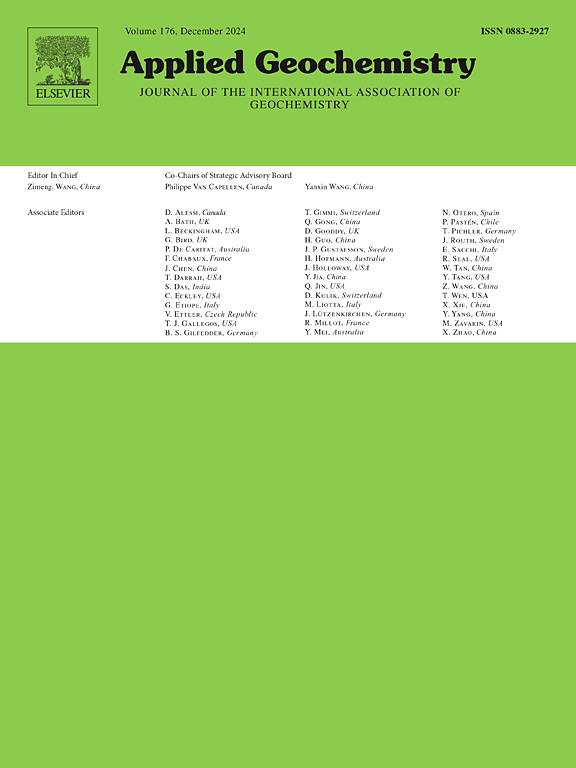Comparison of naturally altered archaeological glasses from a marine environment with accelerated laboratory tests; implications for modelling long-term corrosion
IF 3.1
3区 地球科学
Q1 GEOCHEMISTRY & GEOPHYSICS
引用次数: 0
Abstract
Glass ingots of lead silicate composition from the shipwreck of the Albion were studied to ascertain the chemistry and mineralogy of alteration products after exposure to seawater for 220 years. Alteration observed on natural samples was compared to that of the same glasses exposed to short-term, high temperature, laboratory dissolution tests in synthetic seawater and significant differences were observed. Alteration layers on natural samples were more chemically complex having sequestered high concentrations of elements present only at trace quantities in seawater. Electron microprobe analysis and microfocus x-ray absorption spectroscopy shows that P, most likely released by biological activity in the vicinity of the wreck, accumulated in naturally altered samples to form Pb–Ca-phosphate phases whilst Pb-sulphate phases formed in laboratory tests. Meanwhile Fe, present at < 0.3 wt % in the glass and ppb concentrations in seawater, accumulated to form Fe-silicates whilst Mg-silicates predominated in laboratory tests. Biologically induced corrosion of naturally altered samples was also considered. Experiments conducted to test barnacle settlement rates suggest that biotoxic elements within the glass, primarily Pb but potentially also Cu, Co and Ni deterred barnacle settlement. Despite this toxicity, some colonisation of the glass surface by both barnacles and bryozoan did occur and, whilst barnacles appeared to protect against chemical attack, bryozoan colonies caused increased cracking, possibly due stress created at the glass surface. Results highlight the challenges in recreating open, natural systems in laboratory settings and demonstrate that elements present at low concentrations can have a significant impact over long timescales.
海洋环境中自然蚀变的考古玻璃与加速实验室试验的比较;模拟长期腐蚀的意义
对“阿尔比恩”号沉船上的硅酸铅玻璃锭进行了研究,以确定其在海水中浸泡220年后的蚀变产物的化学和矿物学特征。在天然样品上观察到的变化与在合成海水中暴露于短期、高温、实验室溶解试验的相同玻璃的变化进行了比较,观察到显著差异。天然样品上的蚀变层的化学性质更为复杂,因为它隔离了高浓度的海水中仅存在微量的元素。电子探针分析和微聚焦x射线吸收光谱分析表明,P很可能是由沉船附近的生物活动释放的,在自然改变的样品中积累,形成pb - ca -磷酸相,而在实验室测试中形成pb -硫酸盐相。与此同时,Fe在<;玻璃和海水中ppb浓度为0.3 wt %,积聚形成铁硅酸盐,而镁硅酸盐在实验室测试中占主导地位。还考虑了自然改变样品的生物诱导腐蚀。测试藤壶沉降率的实验表明,玻璃中的生物有毒元素,主要是Pb,但也可能是Cu, Co和Ni,阻止了藤壶的沉降。尽管有这种毒性,但藤壶和苔藓虫在玻璃表面的一些定植确实发生了,而藤壶似乎可以保护玻璃免受化学攻击,苔藓虫的定植导致玻璃开裂增加,这可能是由于玻璃表面产生的应力造成的。结果强调了在实验室环境中重建开放的自然系统所面临的挑战,并表明低浓度的元素可以在长时间尺度上产生重大影响。
本文章由计算机程序翻译,如有差异,请以英文原文为准。
求助全文
约1分钟内获得全文
求助全文
来源期刊

Applied Geochemistry
地学-地球化学与地球物理
CiteScore
6.10
自引率
8.80%
发文量
272
审稿时长
65 days
期刊介绍:
Applied Geochemistry is an international journal devoted to publication of original research papers, rapid research communications and selected review papers in geochemistry and urban geochemistry which have some practical application to an aspect of human endeavour, such as the preservation of the environment, health, waste disposal and the search for resources. Papers on applications of inorganic, organic and isotope geochemistry and geochemical processes are therefore welcome provided they meet the main criterion. Spatial and temporal monitoring case studies are only of interest to our international readership if they present new ideas of broad application.
Topics covered include: (1) Environmental geochemistry (including natural and anthropogenic aspects, and protection and remediation strategies); (2) Hydrogeochemistry (surface and groundwater); (3) Medical (urban) geochemistry; (4) The search for energy resources (in particular unconventional oil and gas or emerging metal resources); (5) Energy exploitation (in particular geothermal energy and CCS); (6) Upgrading of energy and mineral resources where there is a direct geochemical application; and (7) Waste disposal, including nuclear waste disposal.
 求助内容:
求助内容: 应助结果提醒方式:
应助结果提醒方式:


